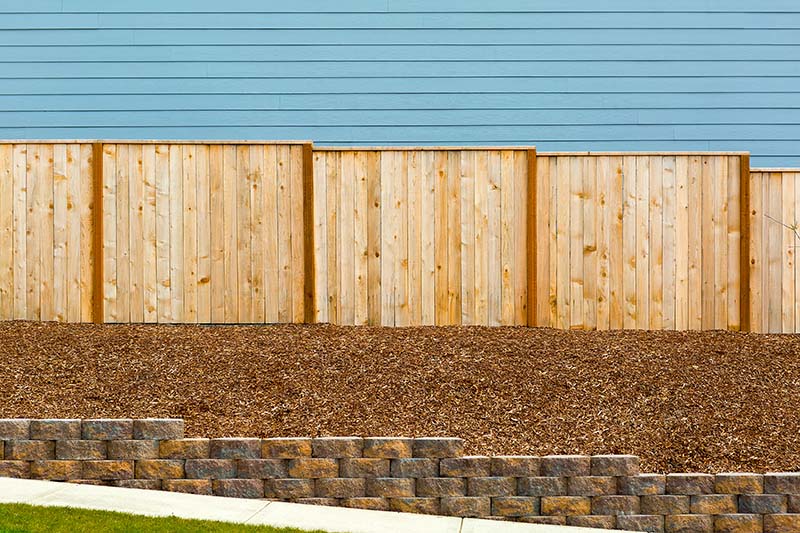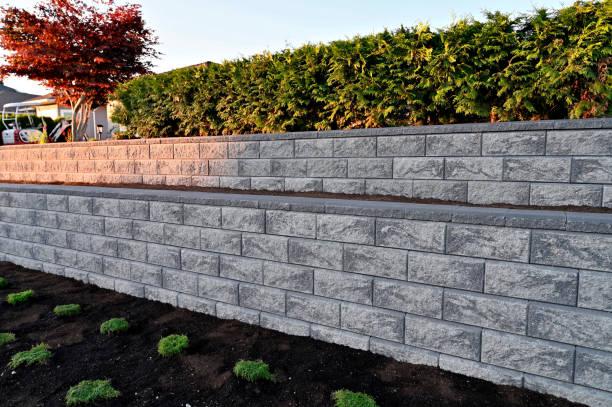Key Considerations for Building Efficient Retaining Walls in Your Lawn
When you're taking into consideration constructing a preserving wall surface in your lawn, it's important to think about numerous crucial aspects. The wall surface's objective, the materials you'll use, and the details dirt conditions can all impact its performance and long life. You'll likewise need to browse regional building ordinance and strategy for appropriate drainage. But just how do you ensure your design not just meets these needs however likewise boosts your landscape? Allow's explore the important steps with each other.
Understanding the Function of Your Retaining Wall
When you believe about developing a preserving wall, consider its major objective: supporting dirt and stopping disintegration. Retaining walls provide essential assistance for sloped landscapes, assisting to maintain dirt stability. You'll locate they're important in areas where water drainage might otherwise get rid of dirt, leading to expensive fixings and landscape damage.
By holding back earth, these walls produce degree surface areas for gardens, patios, or pathways. This not only improves your backyard's looks but also promotes much better drain, minimizing water merging in undesirable locations. If you're dealing with high slopes, a sound retaining wall can stop landslides, making certain safety and security for you and your building.
Inevitably, understanding the purpose of your retaining wall will assist your style decisions and assist you produce a practical, resilient structure that satisfies your requirements. So, take a moment to assess your landscape; it'll settle in the future.
Choosing the Right Products
When picking products for your retaining wall surface, you'll want to think about toughness, visual appeals, and cost. Each variable plays an essential duty in guaranteeing your wall surface stands the test of time while looking terrific and fitting your budget plan. Let's explore just how to make the finest choices for your project.
Material Durability Variables
Selecting the best materials is essential for the durability and efficiency of your retaining wall, since their longevity straight impacts the wall surface's capability to withstand environmental stresses. Begin by considering your local environment; materials like concrete and rock withstand moisture and temperature variations well. If you live in a location prone to hefty rains, go with products with great drainage homes, like gravel or permeable blocks, to prevent water buildup.
In addition, think of the soil problems on your home. Some products carry out far better in details soil kinds, so it is very important to match them appropriately. Ultimately, know possible wear from insects or disintegration. Selecting long lasting materials warranties your retaining wall stands solid, protecting your yard for several years to find.
Visual Design Selections
Resilient products not just ensure your retaining wall surface's architectural honesty yet likewise play an essential duty in its visual appeal. Don't forget regarding the wall's form-- curved walls can produce a softer look, while straight lines can really feel much more organized. By very carefully selecting products that line up with your visual vision, you'll improve your outdoor space while guaranteeing your wall stands strong against the components.
Cost-Effectiveness Evaluation
Selecting the best materials for your retaining wall isn't simply regarding looks; it's likewise essential for your budget plan. When picking materials, take into consideration both upfront expenses and lasting durability.
Do not neglect to aspect in maintenance prices. Some products, like all-natural rock, can include elegance and require less maintenance, while others might require routine therapies
Inevitably, weigh the pros and cons of each alternative versus your budget plan and the wall's designated function. Spending carefully in products currently can avoid expensive problems later on. Choose products that stabilize expense and efficiency efficiently.
Analyzing Dirt Problems and Water Drainage
As you start your job, assessing soil problems and water drainage is crucial for the success of your retaining wall. Sandy dirt drains pipes well however does not have security, while clay soil can preserve dampness, leading to press on your wall.
Following, evaluate the slope of your backyard. If water naturally flows towards your wall surface, you'll require to apply a drainage solution to stop disintegration and stress build-up. Think about installing perforated pipelines or gravel backfill behind the wall surface to help with drainage.
Finally, observe any neighboring trees or greenery; their origins can affect dirt security. By comprehending your dirt conditions and applying appropriate water drainage, you'll create a strong foundation for your retaining wall that stands the test of time.
Complying With Local Structure Codes
Prior to you start developing your retaining wall surface, you need to research local guidelines to guarantee compliance. It's important to recognize what permits you should get, as this can save you from pricey fines or having to remodel your work. Taking these steps seriously will assist you develop a safe and effective framework.
Study Local Regulations
Comprehending local guidelines is important when intending your retaining wall surface task, specifically given that constructing codes can differ greatly by location. Beginning by consulting your neighborhood structure division or town to find out about particular demands. Look for standards on wall surface elevation, products, water drainage systems, and architectural honesty. Many locations have constraints on the kinds of materials you can use and how high you can build. You'll also want to take right into account the zoning regulations that may affect your project. Ignoring these regulations can bring about costly penalties or the demand to redesign your work. By doing your study upfront, you can ensure your retaining wall fulfills all necessary codes and blends seamlessly right into your yard.
Acquire Necessary Licenses
Once you've investigated regional regulations, the following step is site web to obtain the essential permits for your retaining wall project. They may need particular plans or engineering evaluations, particularly for larger walls. Protecting the appropriate authorizations can conserve you from pricey penalties or having to dismantle your wall surface later on.

Preparation the Style and Aesthetics
As you commence intending the style and looks of your retaining wall surface, consider how it will certainly integrate with the bordering landscape. Consider the products you'll make use of-- stone, block, or concrete-- and how they'll complement your home's style and the natural environments in your yard. Choose colors and appearances that mix seamlessly with existing functions like outdoor patios, pathways, or yards.
Next, visualize the wall's form and height. Curved walls can soften an inflexible landscape, while straight lines may share an extra modern-day look. Do not fail to remember to incorporate plants and plant around the these details wall for an all-natural touch; this can enhance its allure and integrate it right into the atmosphere.
Last but not least, keep in mind functionality. Your layout ought to not just be aesthetically pleasing however also serve its purpose successfully. By thoughtfully preparing these elements, you'll produce a preserving wall surface that enhances your lawn's elegance while fulfilling its architectural role.
Determining Elevation and Density Needs
To develop a tough retaining wall, you require to properly calculate its height and density demands based upon the dirt conditions and the elevation of the incline it will support. Begin by evaluating the incline's angle and the sort of soil, as different dirts apply varying amounts of pressure.
For walls over four feet high, take into consideration a thickness of at the very least 12 inches. If the wall surface is taller, increase the thickness proportionally to preserve security.
Following, compute the elevation of the wall surface by gauging the vertical range it needs to maintain. For every single foot of height, you should usually prepare for a thickness of one-third of the wall surface's elevation.
Constantly bear in mind to account for extra variables like drainage and backfill, which can influence your wall's design. Proper computations now ensure your retaining wall surface stands solid and lasts for several years to come.
Upkeep and Longevity Considerations
While maintaining your retaining wall surface could appear like a reduced top priority, neglecting it can lead to significant issues over time. Regular evaluations are important; look for cracks, protrudes, or any kind of indicators of water damages. Attending to these issues early can save you from costly repairs later on.
Maintain an eye on water drainage systems, also. Obstructed drains pipes can create water to accumulate, putting in pressure on your wall surface and endangering its security. Clear particles and warranty correct flow to maintain long life.
You might likewise want to assess securing your wall to protect it from dampness and weathering. Depending on the material, this might call for reapplication every few years.
Lastly, landscape design around your wall surface can sustain its stability. Prevent planting big trees close by, as their origins can weaken the foundation. With aggressive upkeep, your retaining wall can offer you well for many years to find.

Frequently Asked Inquiries
Can I Develop a Retaining Wall by Myself, or Should I Hire an Expert?
You can certainly construct a keeping wall surface yourself if you have the right devices and expertise. Nevertheless, working with an expert warranties it's Get the facts done correctly, specifically for bigger or more complicated frameworks. Consider your ability degree before determining.
What Are the Many Usual Blunders Made When Building Retaining Walls?
When developing retaining walls, you could forget proper drain, miss using the right products, or overlook support. These common mistakes can lead to architectural failing, so take your time and strategy thoroughly to prevent concerns.
How Do I Know if My Retaining Wall Needs Reinforcement?
You'll understand your retaining wall surface needs reinforcement if you discover fractures, leaning, or protruding. Look for water merging behind it or dirt disintegration near the base. Address these indicators immediately to stop further damage.
What Plants Are Suitable for Landscaping Around a Retaining Wall?
When landscaping around a keeping wall, think about utilizing low-maintenance plants like succulents, decorative yards, or creeping ground covers - OKC Precision Retaining Walls. They'll thrive in those problems and include elegance while protecting against dirt disintegration around your wall surface
Just How Can I Protect Against Disintegration Around My Retaining Wall?
To avoid disintegration around your retaining wall, you can plant ground cover, use compost, and mount water drainage systems. On a regular basis look for water build-up and readjust landscape design to redirect runoff far from the wall surface.